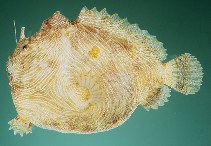http://www.fishbase.org/Summary/speciesSummary.php?genusname=Antennatus&speciesname=linearis ---> http://192.134.151.83/Summary/speciesSummary.php?genusname=Antennatus&speciesname=linearis
http://192.134.151.83/Summary/speciesSummary.php?genusname=Antennatus&speciesname=linearis ---> https://fishbase.mnhn.fr/Summary/speciesSummary.php?genusname=Antennatus&speciesname=linearis
https://fishbase.mnhn.fr/Summary/speciesSummary.php?genusname=Antennatus&speciesname=linearis ---> https://fishbase.mnhn.fr/summary/Antennatus-linearis.html
Antennatus linearis, Pygmy anglerfish

You can
sponsor
this page
Common name (e.g. trout)
Genus + Species (e.g. Gadus morhua)
-

-
About this page
-
Languages
-
User feedbacks
-
Citation
-
Uploads
-
Related species
-


 Pygmy anglerfish
Add your observation in
Fish Watcher
Upload your
photos
and
videos
Pygmy anglerfish
Add your observation in
Fish Watcher
Upload your
photos
and
videos
Pictures
|
Google image
 Antennatus linearis
Antennatus linearis
Picture by
Randall, J.E.
Teleostei (teleosts) >
Lophiiformes
(Anglerfishes) >
Antennariidae
(Frogfishes)
Etymology:
Antennatus:
From Latin, antenna, antemna = sensory organ, that has got antennae (Ref.
45335
)
;
linearis:
Named in reference to its unique pattern of lines on the head and body.
.
More on authors:
Randall
&
Holcom
.
Environment: milieu / climate zone / depth range / distribution range
Ecology
Marine; demersal; depth range 4 - 33 m (Ref.
40786
). Tropical
Distribution
Countries
|
FAO areas
|
Ecosystems
|
Occurrences
|
Point map
|
Introductions
|
Faunafri
Indo-West Pacific: currently known only from the coast of East Africa from northern Mozambique to Durban; Aldabra and the Comoro Islands in the western Indian Ocean; Molucca Islands in Indonesia and the Hawaiian Islands.
Size / Weight / Age
Maturity: L
m
?
range ? - ? cm
Max length : 7.5 cm SL male/unsexed; (Ref.
48635
)
Dorsal
spines
(total): 3;
Dorsal
soft rays
(total): 12-13;
Anal
soft rays
: 7;
Vertebrae
: 18. Short caudal peduncle present; illicium lacks a distinct esca, its length 1.4-2.0 times length of second dorsal spine; second dorsal spine tapering, 10.2-13.4% SL; light brown with two sets of numerous, parallel, curving, dark brown lines, one on body extending downward and posteriorly, then curving forward on abdomen, the other on head curving upward and posteriorly from chin; large, obscure, blackish blotches sometimes present on body.
Secretive on shallow coastal reefs. Among rocky boulders or under large coral rubble pieces (Ref.
48635
). Benthic (Ref.
58302
).
Life cycle and mating behavior
Maturity
|
Reproduction
|
Spawning
|
Eggs
|
Fecundity
|
Larvae
Oviparous.
Randall, J.E. and R.R. Holcom
, 2001.
Antennatus linearis
, a new Indo-Pacific species of frogfish (Lophiiformes: Antennariidae). Pac. Sci. 55(2):137-144. (Ref.
40786
)
IUCN Red List Status (Ref.
130435
)
Not Evaluated
CITES
Not Evaluated
Not Evaluated
Threat to humans
Harmless
Human uses
FAO - Publication:
search
|
FishSource
|
More information
Countries
FAO areas
Ecosystems
Occurrences
Introductions
Stocks
Ecology
Diet
Food items
Food consumption
Ration
Common names
Synonyms
Metabolism
Predators
Ecotoxicology
Reproduction
Maturity
Spawning
Spawning aggregation
Fecundity
Eggs
Egg development
Age/Size
Growth
Length-weight
Length-length
Length-frequencies
Morphometrics
Morphology
Larvae
Larval dynamics
Recruitment
Abundance
BRUVS
References
Aquaculture
Aquaculture profile
Strains
Genetics
Electrophoreses
Heritability
Diseases
Processing
Nutrients
Mass conversion
Collaborators
Pictures
Stamps, Coins Misc.
Sounds
Ciguatera
Speed
Swim. type
Gill area
Otoliths
Brains
Vision
Tools
E-book
|
Field guide
|
Length-frequency wizard
|
Life-history tool
|
Point map
|
Classification Tree
|
Catch-MSY
|
Special reports
Check for Aquarium maintenance
|
Check for Species Fact Sheets
|
Check for Aquaculture Fact Sheets
Download XML
Summary page
|
Point data
|
Common names
|
Photos
Internet sources
AFORO (otoliths) |
Aquatic Commons
|
BHL
|
Cloffa
|
BOLDSystems
|
Websites from users
|
Check FishWatcher
|
CISTI
|
Catalog of Fishes
:
genus
,
species
|
DiscoverLife
|
ECOTOX
| FAO - Publication:
search
|
Faunafri
| Fishipedia |
Fishtrace
| GenBank:
genome
,
nucleotide
| GloBI |
Google Books
|
Google Scholar
|
Google
| IGFA World Record |
MitoFish
|
Otolith Atlas of Taiwan Fishes
|
PubMed
| Reef Life Survey | Socotra Atlas |
Tree of Life
| Wikipedia:
Go
,
Search
| World Records Freshwater Fishing |
Zoobank
|
Zoological Record
Estimates based on models
Preferred temperature (Ref.
123201
): 23.9 - 29.3, mean 27.5 °C (based on 1552 cells).
Phylogenetic diversity index (Ref.
82804
): PD
50
= 0.5002 [Uniqueness, from 0.5 = low to 2.0 = high].
Bayesian length-weight: a=0.01995 (0.00906 - 0.04395), b=3.01 (2.83 - 3.19), in cm total length, based on all LWR estimates for this body shape (Ref.
93245
).
Trophic level (Ref.
69278
): 3.7 ±0.6 se; based on size and trophs of closest relatives
Resilience (Ref.
120179
): High, minimum population doubling time less than 15 months (Fec assumed to be > 10,000).
Fishing Vulnerability (Ref.
59153
): Low vulnerability (10 of 100).
Back to Search
Random Species
Back to Top
Accessed through:
Not available
FishBase mirror site :
localhost
Page last modified by :
mrius-barile
- 20 July 2016
Fatal error
: Uncaught ArgumentCountError: Too few arguments to function checkEcotox(), 1 passed in /var/www/html/summary/speciessummary.php on line 2304 and exactly 3 expected in /var/www/html/includes/speciessummary.lib.php:2579 Stack trace: #0 /var/www/html/summary/speciessummary.php(2304): checkEcotox() #1 {main} thrown in
/var/www/html/includes/speciessummary.lib.php
on line
2579
|